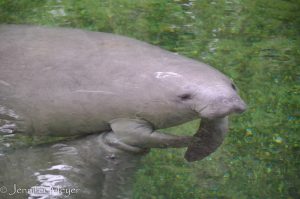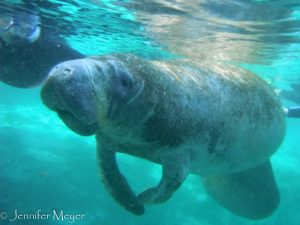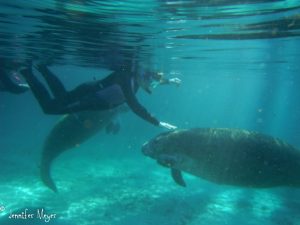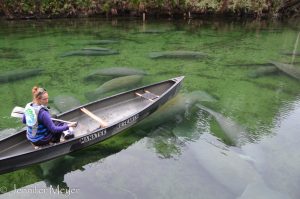One of the best things about having a travel blog is getting suggestions from people on where to go. My friend, Elizabeth, saw we were in the Daytona Beach area and suggested going to Blue Spring State Park to see manatees that come there in the winter. We went the next day, and it was a wonderful experience that we would have missed altogether without the input.
Manatees are giant, slow-moving aquatic mammals that live in warm coastal regions, estuaries, and rivers. In the winter in Florida, they search out natural springs, where the water is a warmer, constant 72 degrees. Each day they must consume 1/10 their body in seagrass and other vegetation. That’s 100 pounds of seagrass for an average manatee. At Blue Spring State Park, the manatees swim into the spring for warmth but must return to the river for food. In 1972, there were only 12 manatees recorded there. Now the park boasts over 200. On the day we arrived, an unseasonably cold day, there were 386!
This is an extremely popular park with limited parking, and we were lucky to get in, even on a Wednesday. There are boardwalks all along the spring inlet with observation decks for viewing manatees. At first look, the manatees looked like giant slugs floating underwater. But every few minutes, one would rise for a breath, and you’d get to see their faces: bulbous heads with narrow snouts, gaping nostrils. And if you watched a while, you could see them interacting. Nudging and nuzzling, rolling in circles… all in the slow motion pace of the manatee world.
There were babies nursing on mamas (just under the flipper), and groups who hung out together. Occasionally, there would be a tiny ruckus – some splashing and diving, but mostly these seem to be Zen-like creatures who seemed content with each other’s presence and the world around them.
A few years ago, Kate and I actually swam with manatees. It was a tour; we donned wet suits in the morning chill and took a boat out to Crystal River, where there were about 50 manatees floating in the “warm” spring water. We were given very specific instructions about how to behave. Let them approach you. If they approach, you can touch them with one hand only. It they roll belly-up, a belly rub is usually welcome. These creatures seemed genuinely curious and friendly, wanting interaction. And going eye to eye with them underwater was really something. Their skin is rough like elephant hide (their closest relative) and there seemed to be a mutual sense of respect between them and us.
Toward the end of our visit, we noticed a woman sitting in a row boat near the spring and another woman snorkeling in the water. Wherever the woman swam, manatees followed. We were intrigued and sat down on the deck to watch. Eventually the snorkeler swam over to the deck and the boater rowed over. It turns out that a manatee had been spotted with a tangle of fishing line around both fins. The snorkeler found the troubled one and managed to cut the lines, but they were still wound around the fins. This is a regular issue with manatees, we were told, and this one may need to be brought in for surgery. Many lose fins this way. The woman we talked to, the one rowing the boat, works for the Manatee Research Foundation, and it is her job to row up to the spring each morning with an underwater GoPro and count all the manatees in the spring.




